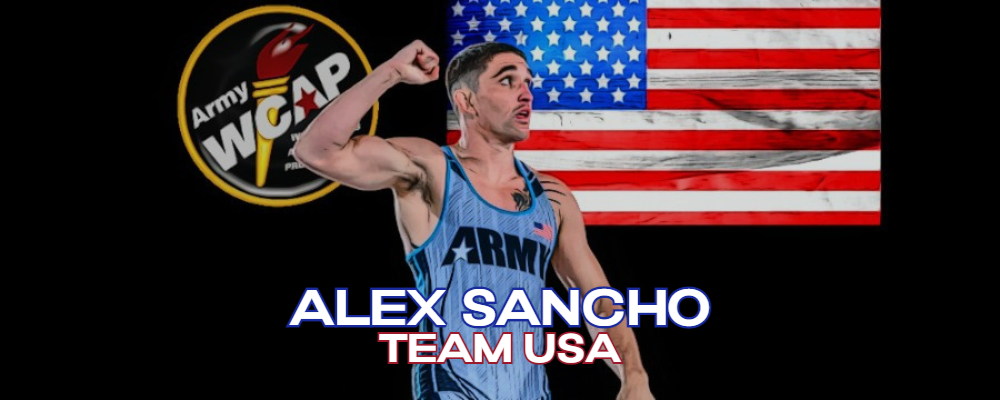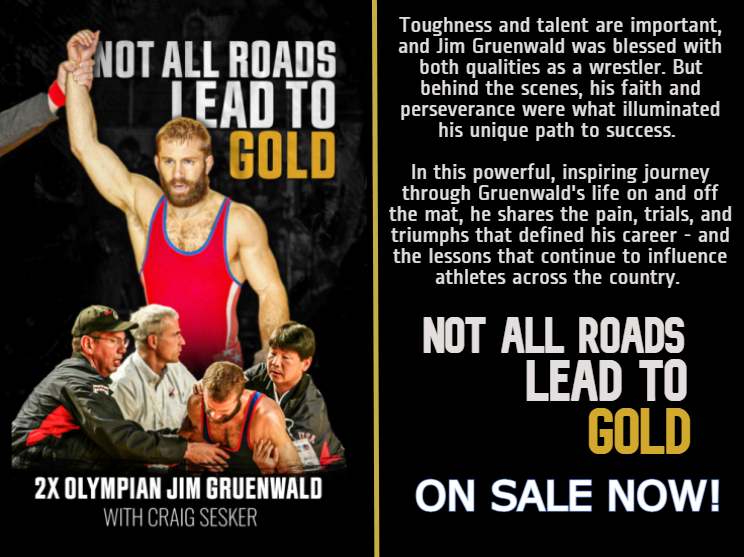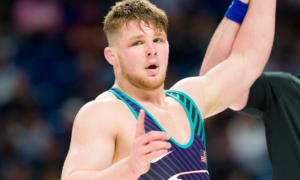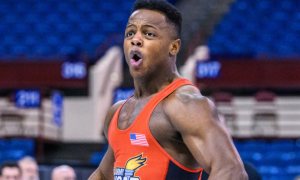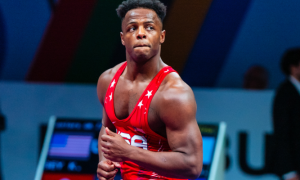Pain from defeat has some hangtime. Losses rattle around in the mind for as long as is necessary until a speck of insight finally reveals itself.
Whatever realization is gleaned does not erase the pain, but it begins to fade just enough for the clouds to part. A little sunlight then peeks through, thus giving way to the discovery of a new dawn approaching. Regular people think of this as hope. World-caliber athletes do, too, but only after paying an experiential price. For this special lot, hope isn’t found within the understanding that there is a grasping-at-straws chance for competitive redemption. Rather, it is understood by retaining lessons learned and applying them accordingly.
2022 US World Team member Alex Sancho (67 kg, Army/WCAP) has no problem prioritizing these lessons. Because, he knows what it is like to eat the pain. Better than most, in fact.
A mere five weeks after representing America at the ’20 Tokyo Olympic Games, Sancho was upset in the World Team Trials final round by Peyton Omania (NYAC/CYC). An unpleasant familiarity. Although Sancho had long been affirmed as one of the country’s premier lightweight competitors — and was, is, a returning Olympian — success in World Team Trial events had eluded him. Prior to his series against Omania last September, Sancho was a four-time World Team Trials runner-up. After it was over, he became a five-timer.
Easy it is for outsiders to still acknowledge what is an otherwise impressive achievement. Just to make five Senior World Team Trials finals says something, doesn’t it? Oh, it sure does, particularly in Sancho’s case considering the pool of competition with which he has had to contend. Not that he sees it that way. The first thing he sees is pain. Vexation in its rawest form.
But unlike his past disappointments, this time Sancho was able to identify what was holding him back and compel a quicker parting of the clouds, so to speak.
It wasn’t due to one in-match decision or another, and it wasn’t because he gave up an ill-timed turn from par terre or phantom caution point. It was a between-the-ears thing. Caught up in chemicals. The problem was fist-clenching, brow-lowering adrenaline. Angst works for some wrestlers, but not all. Sancho had at last gained clarity: in order for him to optimize his capabilities, emotional charges must be properly regulated. Too amped up? No good. Staunchly determined yet also cool and calm? Yeah, that’s his wheelhouse.
Such is the attitude, or “headspace”, as he calls it, that Sancho took with him into this season. During what was an abbreviated post-Trials breather, he reflected upon all things physical and tactical but it didn’t take long for him to gather that the snares were mental. Or more appropriately put, emotional. Which is, in and of itself, quite the breakthrough.
Wrestlers tend not to struggle when it comes to pointing out perceived technical flaws they believe were responsible for defeats. The challenge arrives in uncovering past mental states. What they were doing before and during a match is often much easier for them to recall as opposed to how they were feeling. Athletes don’t always realize what is going through their minds amid the heat of battle. The same is true for most of us. Humans become trapped in moments. Happens in each of our everyday lives, we are simply unaware when it does. Sancho gets this. Now he knows. He holds the key: if Sancho forgets to own the moment, the moment will own him. And rarely has anything positive been derived from that.
The results thus far from this season speak to Sancho’s elevation in consciousness. He went undefeated in domestic competition; won his second-career National title before subsequently making his first Senior World Team; has finished half of his matches via technical superiority; and only one USA opponent — Final X runner-up/U23 World Teamer Alston Nutter — managed to stay within three points of any outcome.
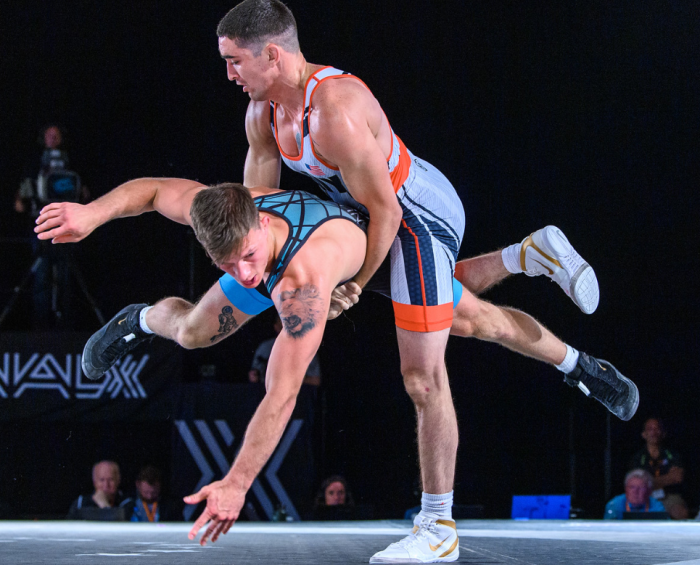
Sancho (red) and former Northern Michigan teammate Nutter (blue) clashed multiple times throughout the 2021-22 USA domestic season, including at Final X: New York to determine the 67 kg US World Team spot. Sancho prevailed in each of their bouts this season but was consistently challenged by the current U23 World roster member. “It is kind of nice,” Sancho says of their battles. “It’s a beautiful thing, to see how far this kid has come, having watched him grow up.” (Photo: Tony Rotundo)
There was pain, but Sancho used it to learn and improve. There is pleasure, as well. The ongoing, if not seemingly perpetual, new-look World Team camp is taking up most of his waking hours. While nearly everything having to do with the National program these days has required an adjustment, it also has Sancho completely engaged with what he loves the most about Greco — technique. Few endeavors does he enjoy more than breaking down technical finer points and explaining, in detail, how he interprets all of their moving parts. Prompting Sancho to analyze scoring actions and his own customized approach to specific in-match scenarios is a fast way to bring a smile to his face. That’s a good thing. He relishes discussing lifts and throws, and places a high value on passing along his knowledge to the next generation.
View this post on Instagram
They would do well to absorb what he has to say. We all would. Whether the topic is par terre offense or overcoming dejection only to once again rise to the top, Sancho’s cognition has been acquired and refined throughout a cavalcade of real-life beta tests. That is how he became an Olympian, and why he continues to grow as both an athlete and individual.
Alex Sancho — 67 kg, Army/WCAP
5PM: It was only a few weeks for you between coming home from the Tokyo Olympics and competing for a World Team spot last September. There wasn’t a lot of time to rest, recover, and quickly prepare for what was a major selection tournament. Why was entering the ’21 Trials important to you?
Alex Sancho: I mean, it was another chance to make a World Team. That is important to anyone at the Senior level who is a US athlete, to make that Team and get an opportunity to earn a medal. That it happened a month after the Olympics, barely a month after, I feel like my headspace wasn’t completely there. My body didn’t recuperate as well from all of the training that I had to do for competing at the Olympics. I didn’t adjust well to having another competition, and that’s just a state that you have to be in. You’re tapering down and training for these big competitions to make a World Team.
Unfortunately, my mindset wasn’t there. I felt like I was in good shape, but it is a big mindset thing. When you’re going out there, you have to be 100% focused. You can’t let things get to you. That’s what happened to me in 2021.
5PM: How long did it take for you to get okay again afterwards, to regroup mentally?
AS: It took about a month or two of being by myself and then training with the guys again. Getting back into the room and back on the training schedule to fully regroup for the next year’s cycle of competitions.
5PM: So, you went from competing in the biggest event of your life thus far where you arm-threw (Artem) Surkov in the Olympics, to traveling all the way back home from Japan only to have a World Team Trials a few weeks later, and then obviously the Trials ended in disappointing fashion. What is the biggest lesson you learned from this whirlwind of experiences?
AS: The biggest thing I learned as an athlete after competing on the Olympic stage and winning the Olympic Trials before that is keeping emotions in check. Gearing up for the Olympics was a two-year process. When I wrestled Ellis Coleman in the finals of the Olympic Team Trials, my headspace, my emotions — everything was completely bottled up. I kind of saw myself wrestling in third-person. Everything was smooth. I wasn’t overthinking anything. I was just out there enjoying myself.
Then at the Olympics and getting Surkov in the first round, I was fired up. I was slapping myself in the face, I was pumped up, and had a good plan for what to do. My emotions were riled up and I was going to release everything.
So the thing that I learned was keeping my emotions in check. To keep my emotions even, where you are in a perfect balance. You are ready to go, but you are also calm and prepared for what is going to happen next. That was just it. Wrestling Peyton Omania in the finals for 2021, I was riled up. I didn’t really have a plan, I just wanted to make the Team again and have another opportunity to get a medal. I was riled up. Omania was talking trash to me during the match, the coaches were talking trash to me… There was a spectrum of emotions going through my head that helped contribute to my downfall and why I didn’t make the Team. I just wasn’t emotionally ready for all of that.
But then you fast-forward to this year and making Final X and wrestling (Alston) Nutter in the finals. I was completely and emotionally ready, my headspace was perfect… I wasn’t fired up, but I was ready to wrestle Nutter. I had a game plan. I wasn’t completely flustered when I wrestled. That is the biggest thing for me. I need to be mentally in-balance with myself when I compete at the World Championships coming up.
5PM: Army couldn’t go on the European tour during the winter, which was a big deal at the time. A couple of months later, Army athletes were not permitted to go to the Pan-Ams, either, and you would have been on that roster. You love international competition more than anything else, so what was it like reconciling that you would have to move forward without having these trips?
AS: For me personally, I have a short-term memory loss thing (laughs). I forget sometimes that I haven’t competed overseas in a long time. That factors in. When I went overseas in June to compete in Rome, I was fired up again. I was like, Oooh, I get to wrestle overseas, I’m excited. I’ve never been on this trip before. My mindset wasn’t there again. Wrestling the French dude in the first match, I was fired up again. I was slapping myself in the face, ready to go, Spenser (Mango) was pumping me up, all this stuff… It’s a mindset game. That’s the biggest thing. Wrestling is a mindset game.
That’s what happened to me. I went out there wanting to bully the French dude and played right into his wrestling game. That kind of messed me up and then I lost it in par terre. I wasn’t completely focused when I went down there. He tried to reverse lift me and got an easy two points off of that when I could have just elbowed him in the face and regained my composure, when I circled in on him. The biggest thing is the mindset for when I compete. If I’m riled up and ready to go, it’s not going to end well for me. I am not a super-aggressive guy when it comes to wrestling. I am more tactical. I like to get to my positions, I like to get to my par terre. Mindset played a big role in the Italy tournament.
The Austria camp afterwards was a different ballgame for me. I had a couple of great guys in the wrestling room. (Morten) Thoresen was there, Mateusz Bernatek was there, a couple of good Swedish guys, the Hungarian team was there… I had great guys to wrestle with. I got to feel what they were doing from par terre and on their feet. They are keeping their heads up and staying in good position. They are not losing position. They are always digging for underhooks and staying in good position. There is nothing too special. There is nothing special about the foreigners. They are not that different from us Americans. They are just staying in really good position and they know how to wrestle a six-minute Greco-Roman match. They know how to get the referees in their favor so they can finish the match in par terre. They know how to get those passivity points and win the match like that.
There is nothing at all special about the guys I am wrestling. I learned that from the camp wrestling Thoresen and all of those guys. In the beginning of the camp, they were beating my ass, but then towards the end of the camp I was beating their asses. My par terre skyrocketed from that camp, as well. I learned so much for my par terre game. In Greco-Roman wrestling par terre, you have to mix it up. You can’t always go to the same thing throughout your entire career. You have to put a little pressure on your cinch and then go into your lift, and I have different ways of doing that now. Different feels. And my gutwrench has also improved. I got a lot of good feels wrestling in Austria with those guys. That was a successful camp.
5PM: Spenser said that you knew you were going to make Final X, that you were basically zeroed in on getting those two matches at the Trials and extremely confident.
Alex Sancho: Yeah, definitely. My focus after 2021 was that I knew I was the best US guy coming into this tournament. I just had to be mentally prepared. I just have to go out there, execute my game plan, and not let emotions get the better of me — that’s what I entered the tournament with. I knew that I was going to make this Team no matter what. The biggest thing was, like I said, emotions. And also, cutting down that weight in a healthy way. It was eating right a month or two out, scratching 68 or 69 kilos right after WCAP practice, making sure that I’m wrestling well at that weight, and going into the tournament just like that.
5PM: Last year after the Olympic Trials when talking about young athletes, you said, “You see it every cycle, new kids coming up and transitioning.” Nutter this year brought that to mind. You knew him prior but he has come of age and you had some very exciting but tough matches against him over the past year. Was there anything about Alston this season and in Final X that surprised you?
AS: I don’t know, man. You have to remember, Nutter and I go back to the Northern Michigan days when he was 16, 17-years-old. He had made his first little trip to Northern, I remember that. I knew him as a baby when he was coming up. It is kind of nice. It’s a beautiful thing to see how far this kid has come, having watched him grown up. I didn’t train him but I was his training partner. Like I said, you do see this every cycle, younger kids coming up. And in the next cycle, there are going to be more. You see it every cycle. It’s not new to me. I was one of those kids. It happens. It’s cool to see.
5PM: Late points, late surges with little time on the clock. You had done it before and you did it against Alston in the first match at Final X. Why do you think this has been a strength of yours in big matches?
AS: It is kind of trial-and-error. I’ve been doing this most of my life. In WCAP, we train for :15 or :30. We go as hard as we can during those :15 or :30. I knew in that situation (against Nutter) that I was down a couple of points and had to do something. So I snapped him down and went to the body; and then as soon as he looked up, he lost position, I attacked the body, and scored my points.
That is what I was talking about earlier. Mentally and emotionally, I was balanced. My mindset wasn’t all over the place. Everything was inside of my body. It was like a third-person, out-of-body experience. I could see myself, I could see what was happening around me and I knew what I was doing. My mind was at peace with itself. I think that is the biggest key, having a balanced mindset when you are out there competing.
5PM: What is your advice for younger athletes when it comes to your lift, especially for those who might have watched you and want to emulate how you do it?
AS: My lift is kind of a hybrid. It is basically both a straddle lift and a straight lift. Sometimes I go straight into it, other times I go into a straddle and kick my right leg out. How I learned to do that was by watching a lot of Filiberto Azcuy, the Cuban World Champion. He had a very, very nasty straddle lift where he pretty much just used his back leg and the other guy would become elevated from that. I saw that and picked a couple of pieces off of his lift.
Aghasi Manukyan, he was my coach at the time, and he always told all of us that you cannot mimic another wrestler. He told us instead to grab their style and make it our own. I took some of Azcuy’s par terre style and made it my own to where I’d kick my right leg out and throw from there in a straight lift. Sometimes, both of their legs are out and I go straight back and hit my throw. It is very explosive, so one thing I’d advise the younger generation to do is a lot of repetitions and use a lot of speed. That way, when you get the other person up in your lift, it is technically well-placed and the speed and explosiveness are just right. When you get him up there to throw, your hips are under him and you are landing on him or on his back. Then you are in already in position to do another lift and finish the match.
That is what I would advise the younger generation to do: a lot of repetitions and watch videos. There are thousands of variations of lifts that you can do. You have to pick one, pick two, or maybe pick three. I had multiple. When I was younger at Northern and training with Aghasi, I was trying to do a reverse lift off of a straight lift, a straddle lift, I was trying to do front headlocks. Out of those four, I chose one, which is the hybrid that Azcuy was using before my time.
5PM: How do you determine what you want to do against a particular opponent from par terre top?
Alex Sancho: I see how the person on bottom is moving, if the guy on bottom is over-defending to the right side or left. I evaluate that. If he is over-defending on the left, I might try to side lift or gut on the right. There are different body types. Take Benji Peak. He’s 6’1, so I’m obviously not going to try to do a crazy lift on him because he is super-lengthy. Instead, I might try to gutwrench him. Against a shorter guy it is easier to do my lift since there is less length involved. The body proportion matters when I’m considering lifting an opponent.
Everything comes naturally to me with par terre. When I get set from top, I already have a game plan, which is to get my lift or my gutwrench. It just comes really naturally to me. That is what happens when you consistently in practice get a lot of repetitions doing those moves.
If I’m behind by two points, I am obviously going to go for a lift so I can get four points and be up by two. But realistically-speaking, you don’t really know what is going to happen until it actually does and you are in that moment. And all of that comes with muscle memory, a lot of practice, and a lot of repetitions.
This type of topic is perfect for Ildar. He loves these types of questions, because he knows that when you get on top of someone and want to lock a gutwrench, it isn’t all about strength. It is more about technique. It is the way you have your lock, your far-side lock. We call that a “knife”. We wrap around the body with our wrists and use the lock as a lever. I’m not using any strength, I am just rotating my forearm into the side of the ribcage. There is a lot of technique with par terre top. You can be the strongest guy but if you don’t have the right footwork when trying to do a lift, you won’t get it launched. It is a lot of footwork, a lot of balancing, and making sure your lock is correct. You don’t want your lock slipping.
5PM: How much of par terre defense is based simply on mentality and attitude, and how much of it for you is actually based on technical strategy? Like for instance taking into account from which side a guy might prefer to get his own lock?
AS: Strategy is definitely a factor. With any opponent, you want to know what they like to do from par terre. That is something you want to have in the back of your mind if you do get put down in par terre. For example, let’s say I’m wrestling Surkov. I know that he is going to try to go elbow-to-elbow, lock my hip, and try to gut me. My approach will then be to have my legs spread out as much as possible — and I am going to be putting a lot of pressure on his lock while moving forward. I’m not giving him any chance to get to his elbow-to-elbow gutwrench.
Another example is if a guy has a nice side lift. I am not going to allow him to get both of his feet positioned to the left side of my stomach, my ribs. And if he does get to that position, then I am going to attack with my elbows and push up into him. That’s my side lift defense. There are many defenses that you have to recognize because a lot of guys have different preferences.
There is also mental toughness. That is a phrase you hear a lot, said a lot, “mental toughness”. You’ve got to have it. When I do get turned in par terre, it is not because it hurts. It is because the other guy had my hips locked and I couldn’t get my hip back down and face the side he wanted to gut me towards, or lift me. It is never really something that is hurting me if I do get turned. It is more that I did not defend it correctly.
5PM: This has been a different World Team camp in a variety of ways for a variety of reasons. What has helped you persevere through it the most so far?
Alex Sancho: I have motivation. My motivation is my family, my friends, and the younger generation. I want to do well. I want to perform at the World Championships, and I am willing to do whatever it takes to win a medal. I’m willing to do anything to earn a medal.
When Ivan stepped in, he told me that he had a plan, and I’ll follow him. I will follow him anywhere. He has a proven reputation for training Greco athletes. He knows how to train us well, and he knows how to bring medals back. This training camp? It has been a great training camp. We have been improving in our explosive techniques. Whenever we are working on our techniques, we are exploding very fast. We have been capitalizing and scoring on our feet; but not just scoring on our feet, we are also doing high-intensity defensive training in the air and trying to score four points off of that. That’s a big deal. We are also implementing tech falls. We have to be tech-falling people.
Everything has been very technical. It has been great so far. This training camp has improved us in our Greco-Roman style and you guys are going to see that at the World Championships. I feel like we are going to perform and do very well.

Listen to “5PM52: Two-Time Olympian Jim Gruenwald” on Spreaker.
Listen to “5PM51: Lining up with Tanner Farmer” on Spreaker.
Listen to “5PM50: Mr. Fantastic Benji Peak” on Spreaker.
SUBSCRIBE TO THE FIVE POINT MOVE PODCAST
iTunes | Stitcher | Spreaker | Google Play Music

Notice: Trying to get property 'term_id' of non-object in /home/fivepointwp/webapps/fivepointwp/wp-content/themes/flex-mag/functions.php on line 999

